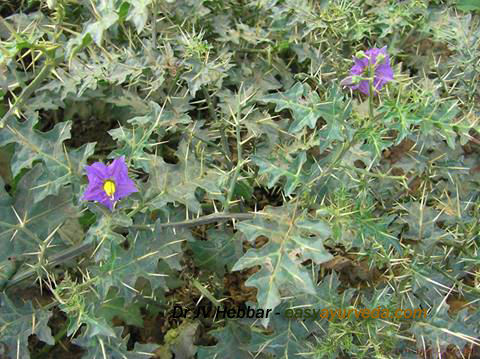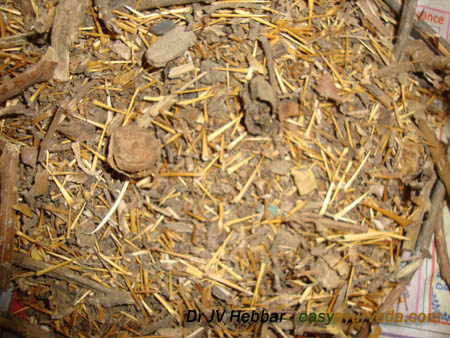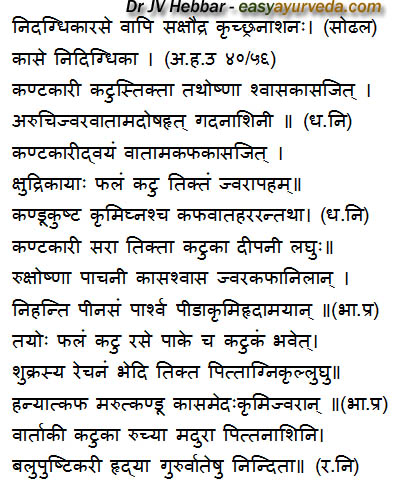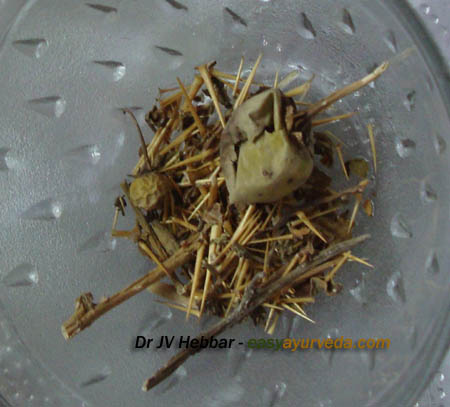Kantakari Solanum surattense / xanthocarpum Uses, Dose, Research, Side Effects
Kantakari is a very useful Ayurveda herb, used widely in the treatment of cough, cold, asthma and such other respiratory tract conditions. It is one among Dashamoola – a group of ten roots. Kantakari in Sanskrit means, the one which is good for the throat. Kantkari is used in laryngitis, hoarseness of voice etc.
Botanical Name : Solanum surattense Burm. F. (Solanum Xanthocarpum Schard. Wendl; S. mccanni Sant.)
Family – SOLANACEAE – Kantakari Kula

Table of Contents
Vernacular Names
Kantakari – full of prickles (short thorns), Good for throat related disorders
Duhsparsha – due to prickles, difficult to tough the plant
Kshudra – a small plant
Vyaghri – it enables the user to have a voice like a lion. It is good for the throat. This synonym is used in a famous asthma medicine called Vyaghri Haritaki Avaleha. Vyaghri refers to Kantakari.
Rashtrika – Plant seen in everywhere
Kuli – Plant is gregarious in nature
Dhavani – Spreads on the ground very quickly
Kshudraphala – Fruits are very small
Chitraphala – Variegated appearance of fruits
Dravani – Liquifies the sleshma
Nidigdhika – grows up fast
Classical Categorization
Charaka
Kasahara – a group of herbs that are used in treating cough, colds.
Shothathara – group of herbs possessing anti inflammatory property,
Hikkanigrahana – group of herbs that are used in relieving hiccups
Kanthya – group of herbs that are good for throat
Angamardaprashamana – group of herbs useful in treating aches and pains
Sushruta – Brihatyadi, Varunadi, Laghupanchamula group of herbs
Vagbhata – Brihatyadi, Varunadi
Bh p Ni – Guduchyadi varga

Distribution
Common in waste lands and road-sides throughout India.
Morphology
Prickly, prostate, perennial herb with compressed yellow straight spines all over the plants
Stem – Erect, solid, branched, dark green glabrous
Leaves – Exstipulate
Inflorescence – Extra axillary, shortly peduncled cyme, sometimes flower is solitary
Flowers – Complete, bisexual, 5 sepals, and 5 petals, bluish purple or violet colour
Fruit – Berry with endospermic seed
Useful part – Root and whole plant
Chemical constituents
Major chemical constituents of Solanum xanthocarpum:
B-Carotene, Disgenin, Carpesterol, Solasodine, Solamargine, B- Solamargine, Solanine, Solasodino-L-Rhamnosy-B-D-Glucoside (Solasurine), Solanocarpine(Solanine-S), Tomatidienol etc.
(Reference: Illustrated Dravyaguna VIjnana, Vol. II, by Dr JLN Shastry)
Part used, Dosage
Part Used: whole plant, root, fruit
Dosage– powder 1-3 g, decoction – 40 – 80 ml, in divided dose, per day, based on condition of the patient and disease.
Varieties
Swetapushpa kantakari
Nila pushpa Kantakari
Medicinal properties
Medicinal properties of Solanum surattense –
Rasa (taste) – Katu (pungent), Tikta (Bitter)
Guna – Laghu (light), Rooksha (dry), Teekshna (piercing)
Vipaka – Katu – Undergoes pungent taste conversion after digestion
Veerya – Ushna – hot potency
Effect on Tridosha – Balances Kapha and Vata Doshas. It increases Pitta Dosha.
According to Bhojana Kutuhalam, the fruit of kantakari is pungent in taste, hot in potency, It stimulates the digestive fire and treats dyspnoea and cough. It cures rhinitis, pain, vitiated vata and kapha dosha and fever.
Sanskrit verse

Use, benefits
Solanum surattense – Benefits and usage
The juice extract of Kantakari along with honey is used in treating dysuria (difficulty in urination)
Of all the herbs useful in treatment of cough, Kantakari is the best one.
Because of its hot potency, pungent taste and Kapha-Vatahara property, it naturally improves digestion strength and is widely used in respiratory disorders.

Shwasajit – useful in treatment of asthma and chronic respiratory disorders.
Aruchihara – useful in relieving anorexia
Jvarahara – useful in fever
Vatahara – useful in treating disorders of Vata Dosha imbalance
Amadoshahara – relieves Ama – a state of disturbed digestion and metabolism
Kantakari fruit is especially useful in treating fever
Kanduhara – it is useful in treating pruritus (excessive itching)
Kushtahara – useful in skin diseases
Krumighna – useful in worm infestation
Hrudamaya – useful in cardiac disorders
Shukra Rechana – it helps in ejaculation
Agnikrut – improves digestion strength
Medahara – useful in obesity and reducing fat and cholesterol deposition
Bala Pushtikara – improves strength, immunity and nourishment.
Its seeds are used in treating amenorrhea, and painful delivery
Kantakari for hair
Fresh plant – 200 grams is collected. Cleaned, It is crushed to extract 30 – 50 ml of juice. It is applied over the scalp, 1 hour before hair wash, to relieve dandruff and to promote hair growth.
Research
Anti oxidant activity – in vitro study
Anti convulsant activity – experimental study
In vitro anti-bacterial activity
Home remedy using Kantakari
Ghee Home Remedy For Dry Cough
Long Pepper – Honey Home Remedy For Cough
Side effects
Its usage in Pitta disorders should be made with caution, due to its hot potency (Ushna Veerya).
It is safe to use in children and during the lactation period.
It is generally considered as safe during pregnancy but consult your doctor for an opinion.
Interaction with medicines, supplements
Can this be used while taking Homeopathic medicine?
Yes. This product does not react with homeopathic medicine.
Can this medicine be continued while taking supplements like multivitamin tablets, Omega 3 fatty acids etc?
Yes. Generally, this product goes well with most dietary supplements. However, if you are taking more than one product per day, please consult your doctor for an opinion.
With western medicines
Seek your doctor’s advice if you are taking this product along with other western (allopathic / modern) medicines. Some Ayurvedic herbs can interact with modern medicine.
If both Ayurvedic and allopathic medicines are advised together, then it is best to take Allopathic medicine first, wait for 30 minutes and then take the Ayurvedic medicine.
Ayurvedic medicines
Ayurvedic medicines with Kantakari as ingredient –
Kantakari Avaleha – used in treating asthma
Vyaghri Haritaki Avaleha – used in treating asthma, bronchitis etc
Ajamamsa Rasayana – useful in improving strength and stamina
Khadiradi Gutika -used in treating cough
Kantakari for hemorrhoids
– By Mr Kanaiyalal:
Kantkari (bethi bhoy ringni in Gujarati) is very useful in all kinds of piles but in bloody piles it is very useful
How to use : Take ripe dry fruit and crush it then take wooden live koyla in a small earthen pot ( matka) and throw some churna on live koyla, much smoke will produce now the patient seat on it and take the smoke on the piles for some time
Advantage : This is an experienced experiment myself and it cures in three to five days and I told many more they are cured with this simple Ayurveda herb.
Sthanika karma (Systemic Acton)
Externally – Anti microbial, relieve pain and swelling. In toothache, Tooth decay and in Hemorrhoids fumigation with its seed is indicated. Oli prepared out of it is beneficial in upper respiratory tract disorders
Internally
Nervous system – Helps to regain consciousness, Pacify vata dosha. In case of Epilepsy its juice can be administered on nostrils and helps to regain consciousness.
Digestive system – Carminative, Anthelmintic, digestive and mild purgative. Indicated in Constipation, loss of appetite, pinworm infestation etc.
Circulatory System – Indicated in Hypertension, Syphilis, edema etc.
Respiratory System – Pacify kapha dosha. Indicated in kasa (Cough), hiccough and in breathing difficulties, asthma etc. Fruit powder along with honey is good for kids for persistent cough.
Excretory system – it increases urine production, Indicated in Bladder stone, urinary tract infection, Dysuria etc.
Reproductive System – Seed is Aphrodisiac and causes uterine contraction. White flowered variety has garbhasthapana property ( prevents abortion). Indicated in Amenorrhea and in Dysmenorrhea and in impotency.
Skin – Induce in skin disorders (Kushta)
Indicated in fever ( jvara)









34 comments on “Kantakari Solanum surattense / xanthocarpum Uses, Dose, Research, Side Effects”
haridatt
very simple and easy to understand
Dr J V Hebbar MD(Ayu)
I am glad you found it useful. Thanks. 🙂
B.Jagannatha Rao
Very useful, crisp information for common men
B.Jagannatha Rao
information creates interest for beginne rswho want to know about Ayurveda
Dr J V Hebbar MD(Ayu)
Thank you very much.: )
ramkrishna somaiya
VERY INFOMATIVE. AND SO SIMPLE TO UNDERSTAND. YOU ARE DOING A GREAT SERVICE TO HUMANITY BY EXPLAINING AYURVED AND RELATED SUBJECTS TO LAY MEN. GOD BLESS YOU. SOMAIYA R.T.(84 YRS.)
Dr J V Hebbar MD(Ayu)
Thank you very much sir. Words like these are my inspiration 🙂
abdul naser
Really very useful for the new generation to understand about herbs an ayurveda treatments
Dr J V Hebbar MD(Ayu)
Thank you sir.
kamlesh
I read and like your articles
Dr J V Hebbar MD(Ayu)
Thank you very much.
andrea haq
May I know the recommended way to take for epilepsy… What part and how much per day plz
Dr J V Hebbar MD(Ayu)
Hi, for a condition as important as epilepsy, rather than relying on this herb, it is better to consult a healthcare practitioner.
Naresh Makwana
Very nice, still more elaborate the uses in Ayurvedic medicine. % used in medicine.
Dr J V Hebbar MD(Ayu)
Hi, Thanks for the suggestion. 🙂
If you click on the name of the medicine, it will lead to article with details of respective medicines.
Best regards
pushpa
Sir . myself Pushpa I m using kantakari juice n obesity juice in empty stomach with a time gap of 15 mins and also taking kanchnar guggul tablet after half an hour of meals n triphala churna after another half an hour as prescribed by ayurved doctor but feeling much garstic n stomuch swelling.. I . please suggest me what to do? Are these any side effects of these medicine s?
Dr J V Hebbar MD(Ayu)
Hi, There are no big side effects with all the three medicines.
Try taking Kantakari juice, after food, along with Triphala churna. This may reduce gastritis.
Kamal Sharma
Very informative!
Ashish bhansali
I have psoriasis and my doctor has adviced to use kantkari juice to supress the itching. The article helped a lot in understanding. Thanks for the information
Dr Malini Bhat
You are Welcome sir.
Dr. HITESH Acharya
In this article an experiment of it’s fruit’s smoke for trtmnt of piles described by Kanailal is quite interesting.. Do u agree with same or really it works so??
Dr. HITESH Acharya
Thanks for reply… One such traditional uses of this Herb’s smoke in toothache is also heared from My grandfather also… So that one should be effective also … In this kantakari’ ripened fruit’s dried seed is advised for toothaches…
Dr J V Hebbar MD(Ayu)
oh! Nice to know. Thank you. 🙂
Prof Dr Syed Nisar Hussain Shah
Thank you for nice and instant fresh informations….great job
Dr J V Hebbar MD(Ayu)
Welcome sir. 🙂
ksabdulrehman
Kandakari fruit eating good for urin infectious
Elvis
Is it true that one can have deep or manly voice.
RAMKUNWAR suthar
thank you sir
Seema
Is kantkari useful for hair problems
OfferUp
Is it safe for children sir?
sagar bansode
Helo… plz suggest me is it useful for teeth treatment.
Vedavyas
Hi. Sir. I got these kantakari plant and how to make powder at home. Which part is used to make powder root or leaves or fruit.
Dr J V Hebbar MD(Ayu)
The whole plant is used. Dry it under shade, then pound it and filter it to get powder.